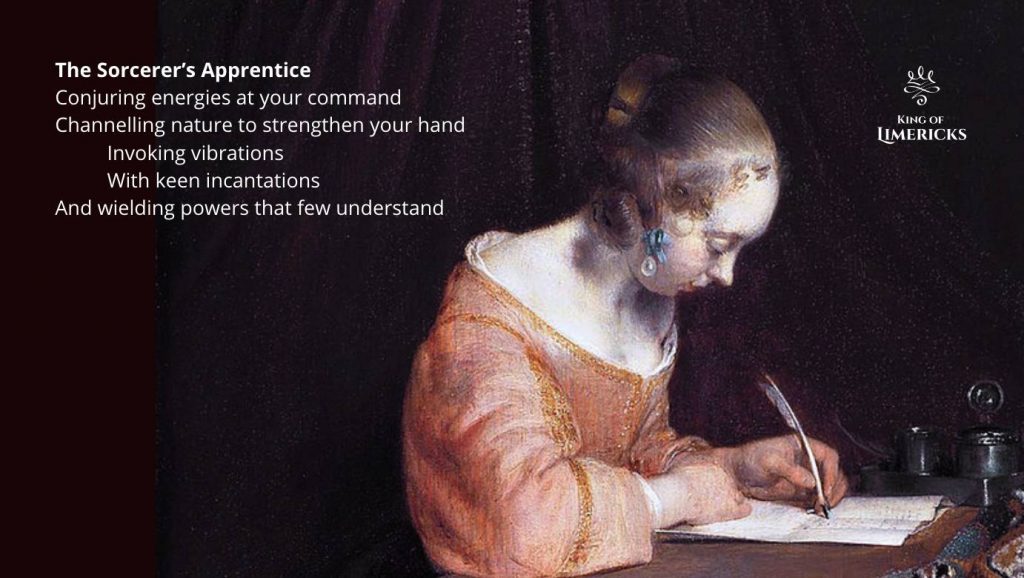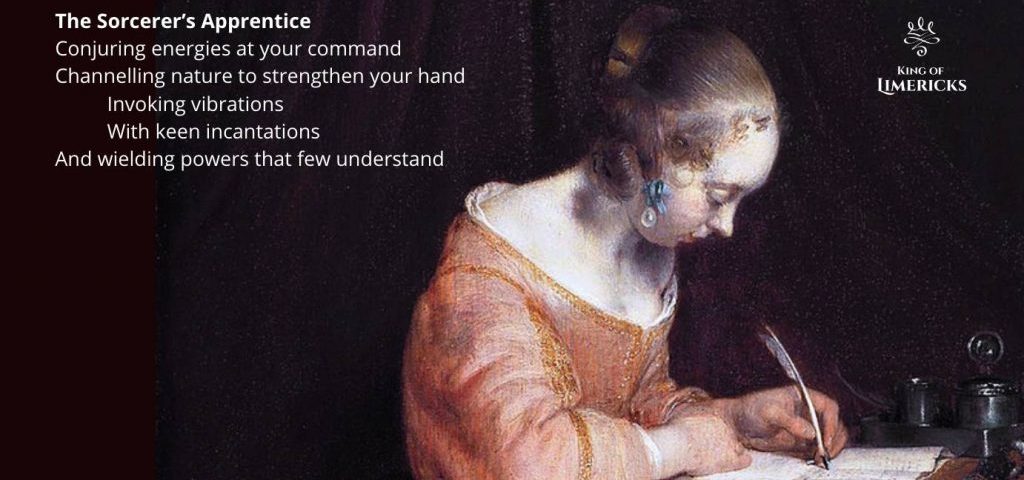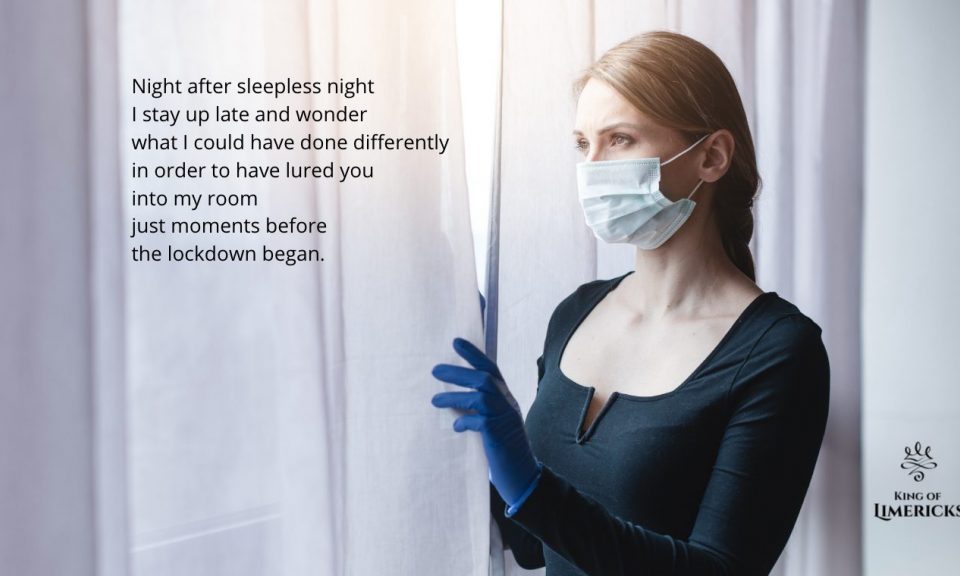
Repentant Limericks about Guilt and Redemption

Fantastic Limericks about Science Fiction

As a writer of esoteric limericks, I don’t have the same number of fans as a superstar like Taylor Swift or JP Sears. But I know there are a handful of readers out there who truly relish a well-crafted limerick. And once in a while someone wants to know, what’s the trick to writing a catchy limerick?
A limerick is basically a five-line poem in which the first, second and fifth lines rhyme together, and the third and fourth lines also rhyme together. Line one, two and five traditionally (but not necessarily) have nine syllables each, while lines three and four have six syllables. Finally, the short poem follows the rhythm of an anapestic meter. In the following article, I’ll explain all these aspects of the limericks.
The subject matter of a good limerick
According to tradition, a limerick deals with a light and whimsical topic, often in an off-color or even obscene fashion. Of course, that is not essential. Personally, I prefer to write limericks about Eastern mysticism, Western philosophy and theoretical physics.
If you have a particularly dirty mind, and that’s fine if you do, then go ahead and write salacious limericks. History has proven this to be an effective way to get a rise out of your audience. But rather than tossing around a lot of foul language and graphic imagery, try instead to employ some subtlety. Rely instead on clever double entendre and the underhanded power of suggestion.
Bon Mollie
There’s a lass who could rhyme with extravagance
She convinced me to give up on abstinence
Her clever word play
It led me astray
But oh what a fine piece of assonance
If you’re not a poet yourself, you may not be familiar with the last word in this limerick. Assonance is a near rhyme, produced by the similar sounding vowles or consanants between two words.
To really get your limerick from B- to grade A, you can try to include some kind of plot twist or surprise ending. This isn’t an easy thing to do, especially when you’re working within the strict confines of rhyme and rhythm. But if you can pull it off, you will win the day.
Like I said, I usually write about more abstract and hifalutin topics, and that in itself can take the audience by surprise. But an unlikely rhyme or unexpected pun can also earn the reader’s admiration.
Objection Overruled
If you don’t like my limericks then go ‘head and sue me
That you prefer Whitman will not make me gloomy
They’re a challenge to follow
For those who are shallow
Perhaps in your head there’s just not enough Rumi
Most important is to write about things you are familiar with and subjects you enjoy. As a poet myself, I sometimes enjoy writing limericks about other poets. Whitman is one of America’s most popular 19th century poets, and Rumi is probably my favorite Persian poet.
The more you know about someone or something, the more you will have to say. And even though it’s just a five-line poem, it will be easier to get the rhyme and meter right when you have a larger body of knowledge and synonyms to draw upon.
The rhyming
This is the most obvious feature of a limerick, and the rhyming requires a lot of attention. So a lot of poets will start by thinking of a set of rhyming words. That is, you can start with the name of a person or place, and then come up with two more words that rhyme with it. Fill in the lines, and your limerick is already more than 60 percent finished.
Typical limericks begin with a phrase like “There once was a man from Peru” or “There once was a waitress named Stacy.” So an excellent way to get started is to come up with an opening phrase that ends with a good place or name that you can easily rhyme. A novice, for example, might want to avoid something like, “There once was a girl from Hawai’i”.
Here’s an example from one of my earliest limericks. (Although I do have a few that predate the Roman Empire.)
Julius Caesar
There once was a fine Roman Kaiser
Who though himself ever the wiser
Like Jesus and Judas
Old Caesar had Brutus
Who made of him fresh fertilizer
The anapest meter
This here is the secret ingredient in a successful limerick. Without the proper meter, the poem just stumbles around, eventually reaching a rhyme. But with consistent anapest, your limerick will gallop to the finish line.
Anapest is simply two short syllables followed by a long syllable. Think of the words “comprehend” and “interrupt”. But you can equally create a limerick with dactyls, a long syllable followed by two shorts, like the word “poetry”, or my name, “Hornaday”. Finally a series of amphibrachs will accomplish the same goal. That’s a long syllable in between two short syllables, like the words “confusing” and “explosion”.
If you use the traditional opening, “There once was a man dressed in purple,” then you have eight words which form three amphibrachs. I underlined the long syllables. (And if you can finish this one, let me know in the comments.)
A strictly anapest opening would be more like “There was once a young lady from Spain.” But let’s not get bogged down in the terminology. And don’t worry if the first line has eight or ten syllables instead of nine. “There once was a man dressed in black,” or in burgundy, are both perfectly acceptable.
But “There once was a girl from Mexico, ” is not. It has nine syllables, but the rhythm is off. See?
When I write about big ideas like German philosophy or Moby Dick, I almost always have 10, 11 or even 12 syllables in the main three lines. And as long as the meter is right, the poem flows just fine.
Echoes of the Irrational
The facts at our fingers are vast and voluminous
But reason alone can be arid and ruinous
Make up your mind
Leave logic behind
And come face to face with the sparkling numinous
This example shows a whopping 13 syllables in each of the major lines. It also employs devices like alliteration (facts and fingers, vast and voluminous) and internal rhyming (the near rhyme of facts and vast) to keep the train moving along.
Just be careful not to cram too many syllables into lines three and four, because that can really block the flow and you lose that bouncing quality that makes a limerick a limerick. You also risk separating the final rhyme too far from lines one and two.
Consider, “I once had a mistress from Mexico.” It starts with an amphibrach and ends on a dactyl, for a total of 10 syllables. But it sounds great, because you still have da-da-DUM, da-da-DUM all the way through. Or DUM-da-da DUM-da-da DUM. Get it?
The alliteration with mistress and Mexico also has a nice sound. Not only that, but you have the promise of a great story. So you’d better deliver by the end of line five.
Breaking the rules
If you’re paying very close attention, you see that some of my longer limericks have breaks in the anapest between lines. When the number of syllables in each line is divisible by three, you can maintain a steady meter. For example, 9-9-6-6-9 (the classic form), or 12-12-6-6-12. But it’s possible to do it differently.
Echoes of the Irrational and other longer limericks break that rhythm in between lines, creating a small pause. This could spoil the effect if not done carefully. I think I do it carefully, but nitpickers might disagree.
Here’s a revised version of that limerick which maintains the meter between every line. (The syllable count is actually 13-12-4-6-14) But the meaning is compromised, and I prefer the original version. What do you think?
Echoes of the Irrational (Revised)
The facts at our fingers are vast and voluminous
Reason alone can be arid and ruinous
Make up your mind
To leave logic behind
As you come face to face with the sparkling numinous
Here’s one that maintains a consistent meter. The steady string of anapest has a satisfying syllable count of 12-12-9-9-12. This should meet or exceed the strictest standards of limerick excellence. I hope you agree.
Decline of the West
Our standard of living has never been higher
You call it success and I call you a liar
Just look what’s in store
And you’ll always want more
When you’re stuck in a cycle of endless desire
The title and theme of this limerick, by way, come from an important book by Oswald Spengler, published in 1918, in case you’re curious to learn more.
Rhyming on the meter
Here’s something else to watch out for. When you end the first line on a dactyl, you’ll want to do the same on lines two and five, and rhyme the entire dactyl. (See Echoes of the Irrational, above.) Mexico and Calico make an okay rhyme, but Mexico and Texaco is a great rhyme. Can you come up with a third rhyme though?
You might have an easier time if she were somehow from Mexico City. I’m sure you’ll have no difficulty finding two-syllable words that rhyme with city.
Again, be mindful of where the long syllable falls. For example, you wouldn’t want to rhyme “seating capacity” with “Mexico City”, because the long syllables don’t line up right.
Once you learn to arrange your rhymes, accents and syllables, you’ll be dazzling readers with magic at your finger tips.
The Sorcerer’s Apprentice
Conjuring energies at your command
Channelling nature to strengthen your hand
Invoking vibrations
With keen incantations
And wielding powers that few understand
Your secret weapon
One more limerick writing tip worth mentioning, is that it helps to have a muse. Whether it’s a pen pal, an imaginary friend or a secret lover, the personification of an outside inspiration can make a vital difference.
Writing can be the loneliest of occupations. All the more so when it’s poetry that you’re writing. So having someone to prod and encourage your creativity will make the writing process all the more satisfying, enjoyable and productive.
Limerick writing resources
I hope you found these limerick writing tips and tricks useful. Now, if you’re ready to start writing better limericks, here a few more resources and references and that might also be helpful.
Use a good dictionary. Poetry is about words, and words have meanings. Words can have very precise meanings, and they can have multiple meanings. A good dictionary will enable you to use the right words to convey the right meanings.
- Lexico offers an online version of the Oxford dictionary.
- Meriam-Webster has an excellent online dictionary as well.
Use a good thesaurus. It not cheating to use a thesaurus. The English language has such an enormous volume of words to choose from, and when you’re writing anything, whether its technical or poetic, a good thesaurus can help you get the right word. It can also help you come up with a word with the right number of syllables and the correct placement of short and long syllables.
- Lexico also has a comprehensive thesaurus.
- Synonym Finder, available from Amazon, is the best thesaurus I’ve used.
Rhyming tools. Sometimes it feels like cheating, but sometimes it just makes sense to find more rhymes. Although in the end, the funniest, most clever and original rhymes won’t appear on these lists.
- Rhymezone is basically my go-to when I’m suffering from rhymer’s block.
Read more poetry. Perhaps the best way to improve your poetry writing is to read more poetry. Find your favorite poet and read all of their work. I’m partial to high brow poets like William Blake, Sylvia Plath and T. S. Eliot. But a light-hearted author like Shel Silverstein is also quite capable of performing word magic.
- The Poetry Foundation is a great resource when you’re looking for fresh inspiration.
- All Poetry is another online source for discovering new, contemporary poets
Read more books. But you don’t have to read poetry to improve your poetry. Reading any good books, even in a foreign language, will empower you with greater verbal facility. I generally alternate between non-fiction, philosophy and the classics. My bedside table currently includes The Story of Spanish, The Sun also Rises, and some short stories from Jorge Luis Borges. I also enjoy a couple of podcasts that I find especially thought provoking.
- The Internet Archive is an excellent resource for free, digital versions of classic texts in the public domain.
- This Jungian Life examines various issues and ideas from a depth psychology perspective.
- The Partially Examine Life explores academic and contemporary topics in philosophy.
One-on-one training. If you really want to go deeper into limericks, you can contact me about personal poetry coaching. Masterclass also offers a course in limericks, but as much as I love their website, I can’t honestly give this program my full endorsement.
Further reading
If you enjoyed these tips, tricks and limerick writing resources, or if you’d like to share a trick of your own, please let us know in the comments section below. Also consider sharing the post and subscribing to the mailing list. You might check out some of these popular articles as well.
- Serious Limericks: There once was an unsmiling rhymer
- Metaphysical Poetry: Words and magic
- Limericks about Introspection
FEATURED IMAGE: Woman writing a letter, by Gerard ter Borch





1 Comment
Hey, here’s mine…
There was once a juxtaposed flower,
Whose smell neither sweet not sour
confused the bees, both the he’s and the she’s,
But looked exceedingly good in the bower